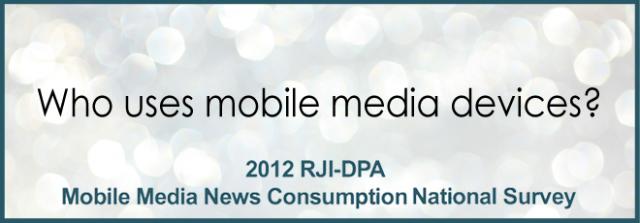
Q1: Who uses mobile media devices?
2012 RJI Mobile Media News Consumption Survey
According to our findings, two-thirds of U.S. adults used at least one mobile media device in their daily lives during the first quarter of 2012. Smartphones and large media tablets are now the preferred mobile media devices. In the two years since Apple defined the large media tablet market with its iPad, nearly a third of all adult mobile device owners in the U.S. said they are using one. For news organizations and advertisers, users of these devices, especially those who own large media tablets, have appealing demographic profiles. They tend to be relatively affluent, well-educated and avid news consumers.
DEVICE CATEGORIES: Nearly 70 percent of mobile media device owners routinely used two or more mobile media devices. Sixty percent of all smartphone owners used at least one other mobile media device. More than half (51%) of all large media tablet owners also used an Apple iPhone. Among smartphone owners who used one or more additional mobile media devices, 44% owned an Apple iPhone, 37% owned a variety of Android-powered smartphone brands, 14% owned a Blackberry, and about 5% owned some other brand. The following table summarizes responses in each device category.
| Device Category | Percent of All Respondents | Percent of All Mobile Device Owners | Most Popular Brands in Each Device Category | Percent of Brand Within Device Category |
|---|---|---|---|---|
| Smart Phones | 57% | 87% | Apple iPhone | 39% |
| Large Media Tablets | 21% | 32% | Apple iPad | 88% |
| Small Media Tablets | 8% | 12% | Amazon Kindle Fire | 68% |
| E-Readers | 13% | 19% | Amazon Kindle | 73% |
| Other Mobile Devices | 21% | 31% | Apple* | 43% |
| *The other Apple mobile devices included the Apple iPod Touch (80%), Apple iPod (7%) and the unspecified Apple devices (11%) |
The following table summarizes the percentage of all mobile device owners who used other devices in each device category (read from left to right).
| Device Category | Smartphone | Large Media Tablet | Small Media Tablet | E-Reader | Other Mobile Device |
|---|---|---|---|---|---|
| Smart Phones | 100% | 33% | 10% | 17% | 27% |
| Large Media Tablets | 89% | 100% | 11% | 22% | 35% |
| Small Media Tablets | 71% | 30% | 100% | 28% | 36% |
| E-Readers | 73% | 36% | 17% | 100% | 35% |
| Other Mobile Devices | 74% | 21% | 35% | 14% | 100% |
| *The other Apple mobile devices included the Apple iPod Touch (80%), Apple iPod (7%) and the unspecified Apple devices (11%) |
GENDER: Men are still somewhat more likely than women to use mobile media devices, but the gap appears to be closing. In this survey, men accounted for just over half of all device users. However, gender ratios varied significantly within device categories. Women accounted for more than half of the small media tablet and e-reader users.
| Device Category | Smartphone | Large Media Tablet | Small Media Tablet | E-Reader | Other Mobile Device |
|---|---|---|---|---|---|
| Men | 60.3% | 63.6% | 48.8% | 45.4% | 54.3% |
| Women | 39.7% | 36.4% | 51.3% | 54.6% | 45.7% |
| All Device Users | 100% | 100% | 100% | 100% | 100% |
AGE GROUPS: Individuals between the ages of 18 and 34 represented the largest percentage of mobile media device users (45%). More than half (51%) of the non-mobile device users were ages 55 or older.
| Age Group | Percent Mobile Device Users | Percent Non-Mobile Device Users | Percent All Respondents |
|---|---|---|---|
| Age 18-34 | 44.9% | 18.7% | 36.3% |
| Age 35-54 | 32.4% | 30.2% | 31.7% |
| Age 55 or Older | 22.7% | 51.1% | 32.1% |
| All Respondents | 100% | 100% | 100% |
Individual users between the ages of 35 and 54 tended to own more mobile media devices than users in other age groups. The following table shows the percentage of all mobile media device owners in each age group who used devices in the five main categories.
| Age Group | Smartphone | Large Media Tablet | Small Media Tablet | E-Reader | Other Mobile Device |
|---|---|---|---|---|---|
| Age 18-34 | 92.7% | 27.9% | 8.6% | 15.6% | 30.9% |
| Age 35-54 | 81.1% | 39.2% | 16.1% | 17.5% | 33.2% |
| Age 55 or Older | 73.0% | 28.3% | 12.5% | 27.6% | 28.3% |
| All Respondents | 84.5% | 31.6% | 11.9% | 19.0% | 31.0% |
INCOME GROUPS: Mobile media device users tended to have higher incomes than non-users of mobile media devices. Among all respondents who indicated that they had an annual household income of $75,000 or more, 81% were mobile device users.
| Income Group | Percent Mobile Device Users | Percent Non-Mobile Device Users | Percent All Respondents |
|---|---|---|---|
| Less Than $75,000/Year | 59.4% | 40.6% | 100% |
| More Than $75,000/Year | 81.3% | 18.7% | 100% |
More than three quarters of the non-users of mobile media devices reported an annual household income of less than $75,000. Among mobile media device users, those with annual household incomes above and below $75,000 were nearly equal.
| Income Group | Percent Mobile Device Users | Percent Non-Mobile Device Users | Percent All Respondents |
|---|---|---|---|
| Less Than $75,000/Year | 52.8% | 76.8% | 60.4% |
| More Than $75,000/Year | 47.2% | 23.2% | 39.6% |
| All Respondents | 100% | 100% | 100% |
The following table compares the income ranges of mobile media owners in the five main categories of mobile devices.
| Income Group | Smartphone | Large Media Tablet | Small Media Tablet | E-Reader | Other Mobile Device |
|---|---|---|---|---|---|
| Less Than $75,000/Year | 52.2% | 40.8% | 48.0% | 51.7% | 53.3% |
| More Than $75,000/Year | 47.8% | 59.2% | 52.0% | 48.3% | 46.7% |
| All Respondents | 100% | 100% | 100% | 100% | 100% |
Income differences were significantly more pronounced for different brands within each device category. For example, 50.8% of smartphone users with an annual household income of $75,000 or more owned an Apple iPhone. Conversely, 50.4% of smartphone users with an annual household income of less than $75,000 owned an Android-powered smartphone. The following table compares income ranges between smartphone brands and large media tablet brands.
| Income Group | Android Smartphone | Apple iPhone | Blackberry Smartphone | Android Large Media Tablet | Apple iPad |
|---|---|---|---|---|---|
| Less Than $75,000/Year | 63.9% | 38.5% | 41.3% | 61.5% | 39.1% |
| More Than $75,000/Year | 36.1% | 61.5% | 58.7% | 38.5% | 60.9% |
| All Respondents | 100% | 100% | 100% | 100% | 100% |
EDUCATION: Mobile media device users tended to include a significantly higher percentage of individuals with university degrees than non-users of mobile media devices.
| Education | Percent Mobile Device Users | Percent Non-Mobile Device Users | Percent All Respondents |
|---|---|---|---|
| No University Degrees | 44.5% | 58.3% | 49.1% |
| 4-Year & Advanced Degrees | 55.5% | 41.7% | 50.9% |
| All Respondents | 100% | 100% | 100% |
Differences in educational levels also were somewhat more pronounced for different brands within each device category. For example, 48.0% of smartphone users without a 4-year university degree owned an Android-powered smartphone. Conversely, 44.5% of smartphone users with a 4-year or advanced university degree owned an Apple iPhone. The following table compares educational levels between smartphone brands and large media tablet brands.
| Education | Android Smartphone | Apple iPhone | Blackberry Smartphone | Android Large Media Tablet | Apple iPad |
|---|---|---|---|---|---|
| No University Degrees | 51.3% | 36.0% | 36.1% | 43.7% | 32.8% |
| 4-Year & Advanced Degrees | 48.7% | 64.0% | 63.9% | 56.3% | 67.2% |
| All Respondents | 100% | 100% | 100% | 100% | 100% |
PRINT SUBSCRIBERS: Nearly equal percentages of mobile media device users and non-users said they subscribed to at least one newspaper or newsmagazine. This suggests that users of mobile media devices are not abandoning print media at a faster rate than non-users of mobile devices.
| Print Subscribers | Percent Mobile Device Users | Percent Non-Mobile Device Users | Percent All Respondents |
|---|---|---|---|
| Yes | 39.8% | 40.2% | 39.9% |
| No | 60.2% | 59.8% | 60.1% |
| All Respondents | 100% | 100% | 100% |
Nearly half of the Apple iPad owners indicated that they still subscribed to printed newspapers or newsmagazines. Only a quarter of the Android-powered large media tablet owners said they subscribed. Apple iPhone and Blackberry owners also were significantly more likely to be printed newspaper or newsmagazine subscribers than were owners of Android-powered smartphones. The following table compares the percentages of print news subscribers between smartphone brands and large media tablet brands.
| Print Subscribers | Adroid Smartphone | Apple iPhone | Blackberry Smartphone | Android Large Media Tablet | Apple iPad |
|---|---|---|---|---|---|
| Yes | 31.9% | 43.2% | 49.3% | 25.0% | 48.1% |
| No | 68.1% | 56.8% | 50.7% | 75.0% | 51.9% |
| All Respondents | 100% | 100% | 100% | 100% | 100% |
For more information, contact Roger Fidler at fidlerr@rjionline.org.

Comments